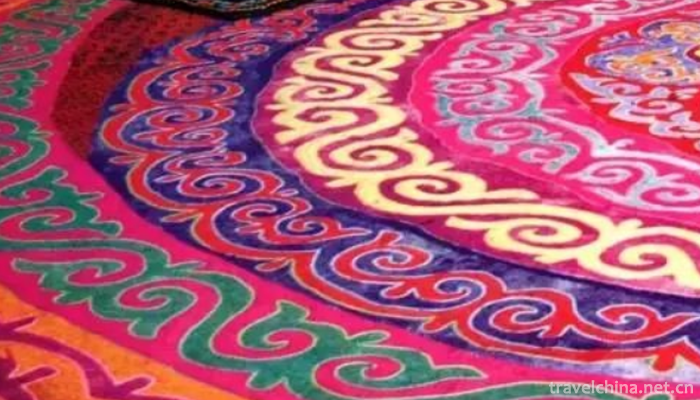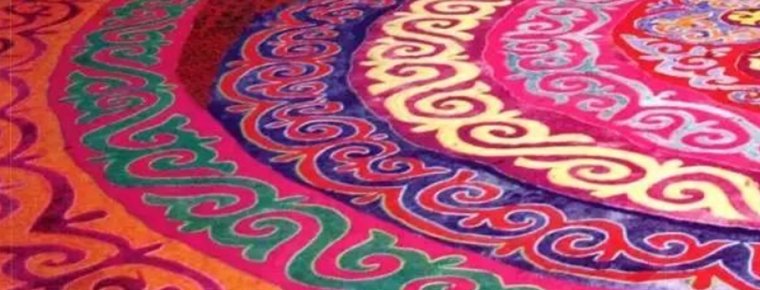Weaving and Dyeing Techniques of Felt and Printed Fabric
Weaving and Dyeing Techniques of Felt and Printed Fabric
Uygur felt, printing and dyeing technology, Xinjiang Uygur Autonomous Region Turpan (now Turpan) local traditional skills, one of the national intangible cultural heritage.
Xinjiang Uygur weaving, printing and dyeing technology has a long history. According to the traditional customs of Uygur people, the indoor vision should be carefully decorated. Wool felt is one of the traditional handicraft for room decoration.
On May 20, 2006, the weaving and dyeing techniques of Uygur felt and printed cloth were approved by the State Council of the People's Republic of China and listed in the first batch of national intangible cultural heritage list, the heritage number is_-23.
historical origin
Uygur's ancestor, the Uygur Uighurs, was a nomadic people. Their living customs are the same as those of other nomadic peoples. They have a long history of making and using felt.
In the first 108 years of Yuanfeng, Emperor Wudi of the Han Dynasty, Princess Xijun married King Wusun Khan as his wife. After three years of living in Yili grassland, she left a poem: "My family married my side today and entrusted herself to King Wusun of a foreign country." The vault serves as a wall and the meat serves as a pulp. It depicts the living conditions of nomadic people in felt houses. Felt making is a great invention of nomadic people. Felt is mainly used to build felts, pave felts, make boots and hats, and some production supplies.
Five years after the founding of Tang Wenzong (840), the Uighurs moved westward into the peripheral areas of the Tarim Basin and changed nomadism to farming. However, the settled Uyghurs still raise a large number of cattle and sheep, produce and use a large number of livestock products, and Uyghurs traditionally sleep solid big soil kang, felt because of its soft moisture insulation, warmth, become the best paving material, in some cases also as decorations hanging on the wall. According to Uygur customs, the places and objects that can be seen by the eyes should be carefully decorated. Of course, the most used felt must be decorated, which produces the craft of making flower felt.
In the Qing Dynasty, the Uygur people created the most unique skills of woodcut printing and woodcut printing.
Inheritance and protection
Inheritance value
Uygur felts and printed cloth have rich patterns and bright colors, which reflect the living conditions of Uygur people and the long history of cultural exchanges between foreign cultures and Han Dynasty. They have high humanistic and artistic values.
Uygur flower felt and printed cloth have a distinct national style, which contains the cultural concept of Uygur people based on historical traditions and religious beliefs. It fully reflects the unique aesthetic taste of Uygur people and is the essence of Arts and crafts of ethnic minorities.
Inheritance status
Since the 1980s, people's living conditions have gradually improved and their lifestyles have changed accordingly, which has led to the gradual disappearance of flower felt. Most of the urban and rural residents in Xinjiang have moved into new houses, and no longer need wall and Kang fencing. The use of color printed cloth in Uygur life is declining, and there is no one in the market. In this situation, felts and color printing cloth artists have changed their careers, and their descendants will no longer inherit this ancient skill. Most of the living old artists are in their twilight years. The ancient handicraft is facing the situation of extinction, which urgently needs rescue and protection.
Inheriting characters
Yasheng Abudu Rehman, male, Uygur, born in 1957 in Hetian, Xinjiang. On May 20, 2006, the first batch of representative successors of national intangible cultural heritage projects were selected and declared by Turpan region of Xinjiang Uygur Autonomous Region.
Yaodasi Ahong, male, Uygur, born in 1948 in Luopu, Xinjiang. On May 20, 2006, the first batch of representative successors of national intangible cultural heritage projects were selected and declared by Turpan region of Xinjiang Uygur Autonomous Region.
Muslim River Qiafuhan was selected as the representative successor of the fourth batch of national intangible cultural heritage projects on July 16, 2014, and was declared by Tacheng area of Xinjiang Uygur Autonomous Region.
Wuji Aximu Wushu was selected as the representative successor of the fifth batch of national intangible cultural heritage projects on December 28, 2017, and was declared by Yingjisha County, Xinjiang Uygur Autonomous Region.
protective measures
From March 12 to April 1, 2016, the first training project of "Flower Felt Technology Inheritance Crowds" was implemented in Xinjiang University. There were 50 participants in the first training course of "Flower Felt Technology Inheritance Crowds".
social influence
Social honour
In January 2010, Kazakh women Reika Tohudar of Fuhai County, Xinjiang Uygur Autonomous Region, made a flower felt to commemorate the 60th anniversary of the founding of New China, and obtained the certificate of "the largest in the world Guinness - the largest area of Kazakh embroidery felt" issued by Guinness Headquarters in Shanghai.
Important exhibition
In 2005, at the China (Shenzhen) International Cultural Industry Expo and Trade Fair, Dentist Abu Du Rehman showed his flower felt making skills with the Xinjiang exhibition group.
In September 2010, at the 19th Uygur Fair, Uygur felt and printed cloth were exhibited as intangible cultural heritage.
On September 20, 2016, the weaving and dyeing skills of Uygur felt and printed fabric were displayed in the first International Cultural Exposition of the Silk Road (Dunhuang).


-
1.Tianmenshan Mountain tourist areaTime 2018-12-12
-
2.Bassoon ba song cuo
Basongtao, also known as Caogao Lake, means "green water" in Tibetan. It is about 18 kilometers long. Its surface area is about 27 square kilometers.
Time 2019-01-02 -
3.West Mountain Scenic Spot of Guiping
Guiping Xishan Scenic Spot, National AAAA Scenic Spot, National Geopark. Located in Guiping City, southeastern Guangxi Zhuang Autonomous Region, Xishan Scenic Spots 1 km away from the outskirts of the
Time 2019-01-13 -
4.Hushan Great Wall
Hushan Great Wall is situated on the Yalu River, 15 kilometers east of Dandong City. It is an important scenic spot in the national Yalu River scenic spot. It is across the river from Korea's Yuchidao
Time 2019-01-16 -
5.Sun Wu Ancient City Tourist Area
Sun Wu Ancient City Tourist Area is a series of scenic spots, such as Sun Tzu's Art of War City, Wusheng Garden, Ancient City Park and Moat Ring Water System
Time 2019-02-13 -
6.Mount Tais Flower Age
Taishan Flower Age Scenic Area in Tai'an City, Shandong Province, is a large-scale agricultural tourism cultural project with five functions of entertainment, sightseeing, picking, catering
Time 2019-02-13 -
7.Ziyunhuashi Lavender Manor
Ziyunhuashi Lavender Manor is located in Jinzhou New District, Dalian City, covering more than 1000 mu, growing in patches of lavender, verbena, sage, roses and other precious vanilla. Dalian's key to
Time 2019-03-22 -
8.Mongolian Sihu Music
Mongolian Sihu music is one of China's intangible cultural heritage. Mongolian Sihu is one of the most distinctive Mongolian musical instruments, stringed instruments.
Time 2019-06-04 -
9.Min Opera Fujian Opera
Fujian Opera is the only existing opera that sings and reads Bai in Fuzhou dialect. It is prevalent in central Fujian, Eastern Fujian and Northern Fujian, and spread to Taiwan and Southeast Asia. It i
Time 2019-06-05 -
10.opera sung in southern tunes
Southern Opera is the earliest mature type of drama in the history of Chinese opera. From the end of Northern Song Dynasty to the beginning of Ming Dynasty (12th to 14th centuries), Southern Opera was
Time 2019-06-07 -
11.Yigou gou
"Yigou" is a traditional drama in Gaotang area of Shandong Province and one of the national intangible cultural heritages.
Time 2019-07-12 -
12.wolong national nature reserve
Wolong Nature Reserve is located in the southwest of Wenchuan County, Aba Tibetan and Qiang Autonomous Prefecture, Sichuan Province, on the southeast slope of Qionglai mountains, 130 kilometers away from Chengdu
Time 2020-11-06